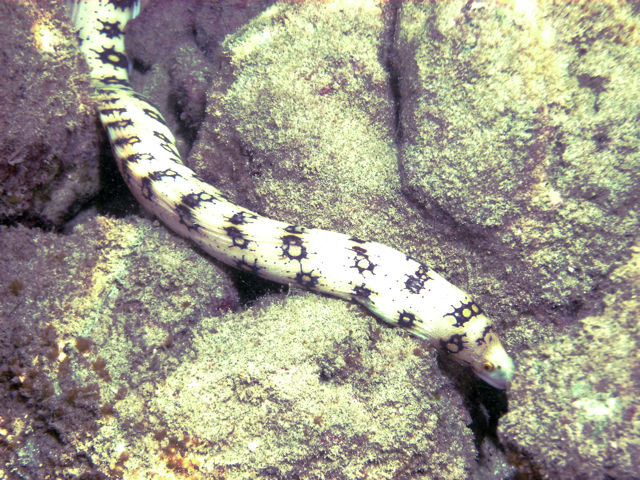Published in the Ocean Watch column, Honolulu Star-Advertiser © Susan Scott
Febrary 15, 2010
Oahu reader Russell Gust recently sent me a picture of an eel, asking me to confirm that it was a snowflake moray. I thought so but looked it up anyway to check its markings.
And oh, what markings. A flurry of black dashes cover the white body of this 2- to 3-foot-long eel, and running down the back and sides are rows of black star-bursts with yellow spots inside. Some variation exists in these colors because as the eel ages, the black dashes turn to speckles and multiply, becoming a blizzard of black on white.
The beauty of this eel has inspired cosmic names for it. The Australians call the species the starry moray, and the scientific name is nebulosa, a nebula being a patchy cloud of luminous space dust.
 Small Snowflake Eel – Hanauma Bay
Small Snowflake Eel – Hanauma Bay
Courtesy of Scott R. Davis
In his excellent field guide to Hawaii’s marine animals, John Hoover features the snowflake eel in all its glory, including five photos, a good story and some intriguing biology. This eel, he writes, “is one of the comparatively few morays known to start life as a female, changing later to a male.”
What do the rest of them do? I wondered.
Most of the world’s moray eels are born either male or female and stay that way.
Zebra and dragon moray eels, however, begin life as either male or female, but if males aren’t around, females of both species take care of the shortage by turning into males. Only snowflake morays are females first and later become males.
And only one goes the other way, male to female: the ribbon moray (Rhinomuraena quaesita). This eel is native to the Indian Ocean and the central and western Pacific but is not found in Hawaii. It is, however, found in aquariums because the remarkable fish not only changes sex, but dramatically changes colors, too.
Before sexual maturity, ribbon eels are jet black with a bright yellow stripe running down the back. One picture I found resembled an upside-down yellow-bellied sea snake, only with trumpets for nostrils. (Type “ribbon eel” in your search engine to see one.)
When a ribbon eel is between 23 and 32 inches long, it becomes a functioning male, shedding sperm externally onto ribbon moray eggs. At this time of life, the eel’s body becomes a lovely light blue, its face and jaws bright yellow.
The coloration from juvenile to male is so different, researchers once thought they were two species and gave the blue phase a second scientific name.
When the ribbon eel reaches about 33 inches long, its male sex organs stop functioning, female sex organs mature and the fish starts laying eggs. As a female, the ribbon moray is entirely yellow or a greenish yellow, living the rest of its life, up to 25 years, as a female, growing to nearly 50 inches long.
Ribbon morays of all ages live in sand or mud holes, from 3 to 185 feet deep. To cement their burrow walls in place, the fish secrete a large amount of slime from their bellies. The slime also helps the delicate-bodied eel slide over rough ocean floors.
Usually ribbon eels live alone, poking their heads from their burrows to ambush passing fish. Occasionally, though, two or more males share the same hole.
As a result of Russell writing me, I learned a lot about the sex lives of moray eels, and enjoyed the research.
When I met Russell a few days ago, he thanked me for identifying the snowflake eel in his picture. I thanked him for asking.
 Small Snowflake Eel – Hanauma Bay
Small Snowflake Eel – Hanauma Bay
Courtesy of Scott R. Davis